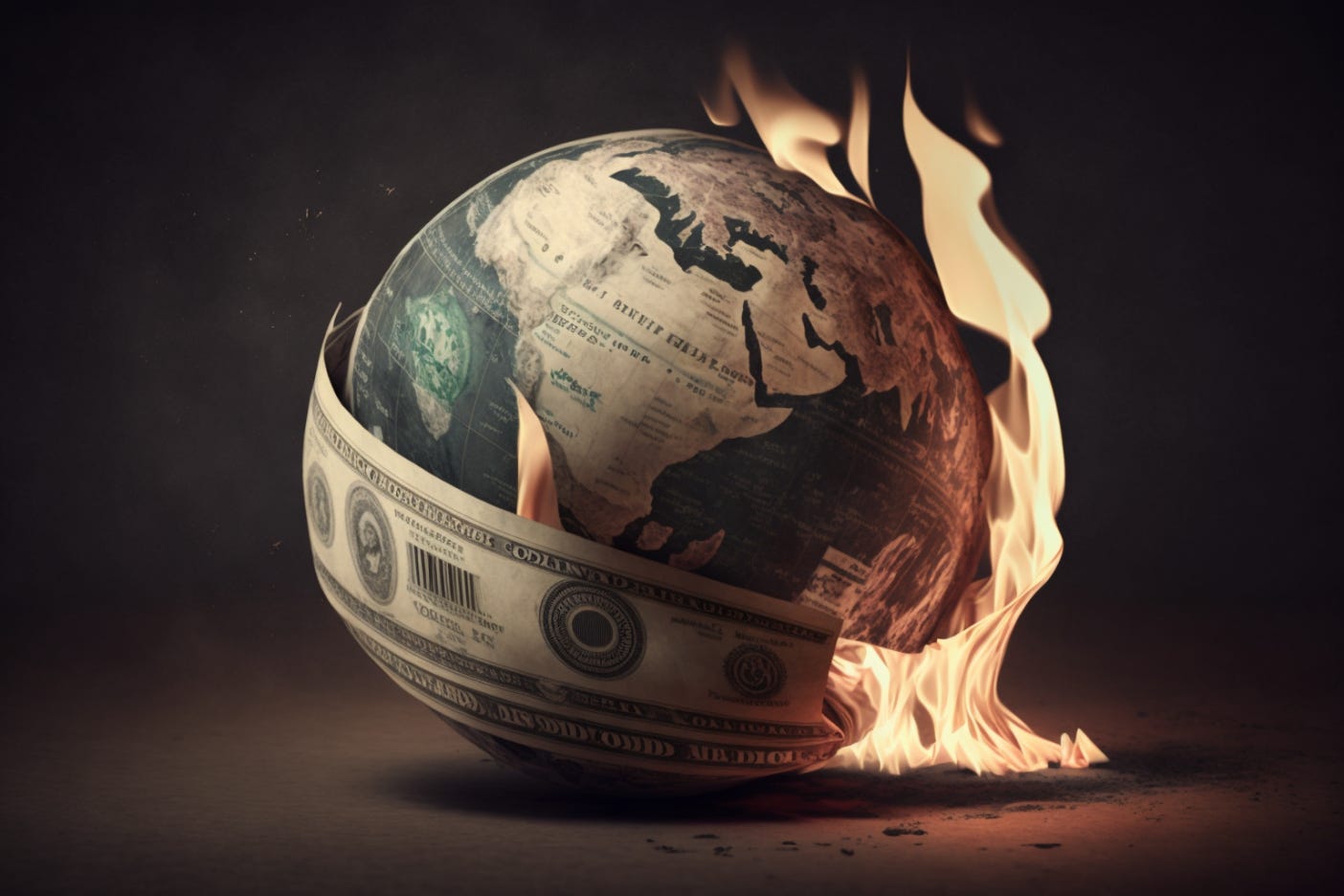
The Flying Frisby - money, markets and more
Business:Investing

The most important price in the world - what happens next?
 2023-04-21
2023-04-21
Before getting started today, I just wanted to flag that Kisses on a Postcard won silver at the New York Festivals Radio Awards for best serialised podcast.
We beat off competition from major production houses, including Lionsgate, the BBC and MediaHuis (Ireland’s largest media group), which is good.
If you haven’t already listened, load it onto your favourite podcast app and play it while you are cooking/walking/driving/ironing. This podcast with music about two boys in WWII will make your life better.
In other news, wearing my comedy hat, there are still about 10 seats left for the Crazy Coqs gig on May 3rd. Some new songs, and plenty of old favourites, these nights are really good fun. Please come.
So to today’s piece …
I've said it before and I'll say it again - the US dollar is the most important price in the world.
The dollar is the global reserve currency, the international money of default.
Global commerce thinks in dollars.
It’s the pricing mechanism for essential materials. Oil, copper, wheat - energy, metal and food, in other words - are traded in US dollars.
The majority of international debt - and there is even more debt than essential material - is traded in dollars. The IMF thinks in dollars.
It’s a determinant of international capital flows: is capital flowing from or to the United States, the largest economy in the world (just)?
I can get all idealistic and say the world would be a better place if gold had this role. It should. It’s independent. It gives no nation or government exorbitant privilege. It lasts longer. It has a proven history. Its purchasing power doesn’t get steadily eroded. New gold supply matches population growth. That kind of stuff. Even bitcoin could work. It’s independent.
But the reality is that the US has got the gig, largely by having such a strong army, and also for the fact that so many around the world trust in America. (I would argue that trust is not what it was. It’s fading. But when push comes to shove it still has the gig).
A strong US dollar should be good for international stability, and thus good for America’s reputation. But the US government likes to print, spend, and then export the inflation and debasement. You just need to look at what it does to know what it prioritises.
How the game works
When the dollar is weak, asset prices rise – and the policy-making world sure does love a bit of asset-price inflation. Borrowing is cheap, house prices go up, stock prices go up, bond prices go up, energy and metal prices go up. The party keeps on rocking. Everybody feels wealthy.
But when the dollar is strong, the world gets the jitters. It starts to think that the asset price bubble that has been inflating since August 15, 1971, might be about to pop.
Those in charge may talk tough. They wear smart, plain suits and look respectable. But then they usually start printing again.
Here’s the thing though. The dollar has just hit an inflection point. It comes to them every now and then. And when it does, it pays to take heed.
Despite the experience of day traders, where prices flicker at you and fortunes are made and lost in tiny fluctuations, if you zoom out a bit, the dollar tends to trend for months at a time, if not years.
The US dollar index (the dollar versus the currencies of its major trading partners) hit a high in 1985. It got so high, in fact, the G5 nations signed the Plaza Accord to get the price back down again. The eventual low did not come until 1992, seven years later.
This wasn’t a one-directional thing, except for the first move. There were counter-trend rallies that lasted several months.
Trend, consolidate, trend
In fact, the process of making a low lasted from 1988 to 1995. It made a low, rallied a bit, made another low and so on. It took time in other words. Seven years.
But then from 1995, the dollar rallied - with the usual drawn-out countertrend moves - all the way to 2001. With the dot-com bust, 9-11, the Iraq War and all the rest of it, the dollar then saw seven years of a bear market and in 2008 it made another low. The price was 71. It rallied for several months, then declined for several months, eventually retesting the low in 2011.
So the bull trend, the bear trend and the process of making lows and highs can each take many years. If you, as an investor, trader or portfolio manager, were able to catch these trends - and be in and out of the market at the right time - you would have been able to magnify your returns many times.
The low in 2011 was 72. Many years of bull market - with the usual drawn-out countertrend moves - followed before the dollar index eventually peaked in September last year at 114.
Here’s the long-term chart that illustrates what I have just described:
Please subscribe to this amazing letter.
When it changes direction, this lumbering beast likes to put in double tops and double bottoms, more than any asset I can think of. Sometimes triple tops and bottoms. It reaches a level, then re-tests it, and then sometimes re-tests it again.
Here’s the thing. It might be putting in one such double bottom now.
The pain, especially of commodity prices, has been relieved somewhat these last few months as the US dollar has come off. This last month has felt particularly good with gold and silver both strong.
But the dollar index hit a low at 101 in early February. It rallied for a few weeks, then came off again. It’s retesting that low now.
Does the US dollar now rally?
I have to say it would be quite normal behaviour for it to do that from here.
I have heard a lot of excitement about silver, for example. You know my cynicism about that metal. Too much excitement and euphoria usually mean declines are upon us. In fact, in the last few days, I have taken a small short against silver in my spread-betting account.
I’m not forecasting the beginning or end of a major dollar cycle. But I do think, assuming 100 on the US Dollar Index holds, we might see a reversal in the dollar that could last several weeks or months.
It comes, interestingly, just as gold is re-testing its highs. Could gold be putting in a double top?
It’s all about that 100-101 level.
Interested in buying gold or silver. My recommended bullion dealer in the UK is The Pure Gold Company, whether you are taking delivery or storing online. Premiums are low, quality of service is high. You can deal with a human being. Both deliver to the UK, US, Canada and Europe, or you can store your gold with them. I have an affiliation deal with them.
This article first appeared at Moneyweek.
This is a public episode. If you’d like to discuss this with other subscribers or get access to bonus episodes, visit www.theflyingfrisby.com/subscribe
More Episodes
 2024-10-16
2024-10-16
 2024-09-22
2024-09-22
 2024-09-15
2024-09-15
 2024-09-11
2024-09-11
 2024-08-28
2024-08-28
 2024-08-25
2024-08-25
 2024-08-22
2024-08-22
Create your
podcast in
minutes
- Full-featured podcast site
- Unlimited storage and bandwidth
- Comprehensive podcast stats
- Distribute to Apple Podcasts, Spotify, and more
- Make money with your podcast
It is Free
- Privacy Policy
- Cookie Policy
- Terms of Use
- Consent Preferences
- Copyright © 2015-2024 Podbean.com




